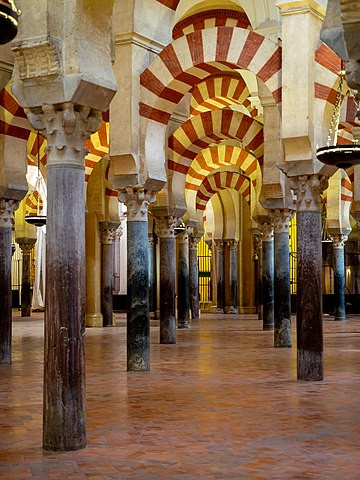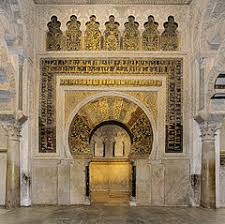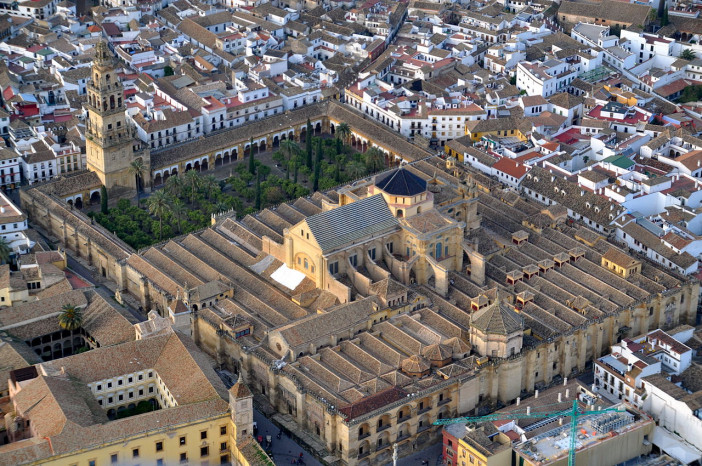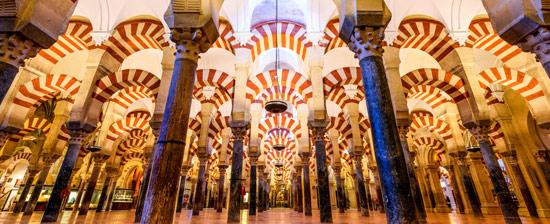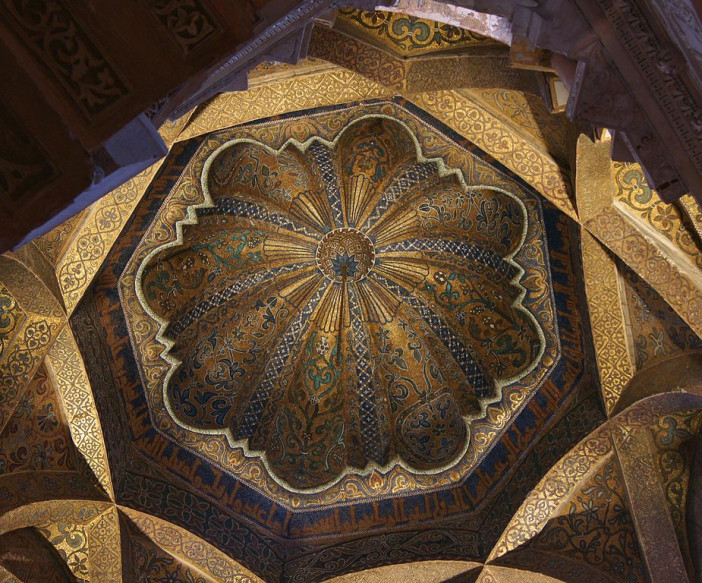The Great Mosque at Cordoba
History
The Mosque–Cathedral of
Córdoba :
also known as the Great
Mosque of Córdoba and the Mezquita, whose ecclesiastical name
is the Cathedral of Our Lady of the Assumption (Spanish: Catedral de Nuestra Señora de la Asunción), is
the Catholic cathedral of the Diocese of Córdoba dedicated to the Assumption of the Virgin Mary and
located in the Spanish region
of Andalusia.
The structure is regarded as one of the most accomplished monuments of Moorish architecture.
According
to a traditional account, a small Visigoth church,
the Catholic Basilica of
Saint Vincent of Lérins, originally stood on the site.
In 784 Abd al-Rahman I ordered construction of
the Great Mosque, which was considerably expanded by later Muslim rulers.
Córdoba returned to Christian rule in 1236 during the Reconquista,
and the building was converted to a Roman Catholic church, culminating in the
insertion of a Renaissance cathedral nave in the 16th
century.
Since
the early 2000s, Spanish Muslims have lobbied the
Roman Catholic Church to allow them to pray in the cathedral. This
Muslim campaign has been rejected on multiple occasions, both by the church
authorities in Spain and by the Vatican.
Description
In planning the mosque, the architects incorporated a number of Roman columns with choice capitals. Some of the columns were already in the Gothic structure; others were sent from various regions of Iberia as presents from the governors of provinces. Ivory, jasper, porphyry, gold, silver, copper, and brass were used in the decorations. Marvellous mosaics and azulejos were designed. Panels of scented woods were fastened with nails of pure gold, and the red marble columns were said to be the work of God. The primitive part of the building, erected under the direction of Abd al-Rahman I., was that which borders the Court of Oranges. Later, the immense temple embodied all the styles of Morisco architecture into one composition.
The Great Mosque of Córdoba held a place of importance amongst the Islamic community of al-Andalus for three centuries. In Córdoba, the capital, the Mosque was seen as the heart and central focus of the city.[28] Muhammad Iqbal described its hypostyle hall as having "countless pillars like rows of palm trees in the oases of Syria".To the people of al-Andalus "the beauty of the mosque was so dazzling that it defied any description."
The main hall of the mosque was used for a variety of purposes. It served as a central Prayer hall for personal devotion, the five daily Muslim prayers and the special Friday prayers. It also would have served as a hall for teaching and for Sharia law cases during the rule of Abd al-Rahman and his successors.
The Great Mosque of Córdoba exhibited features and an architectural appearance similar to the Great Mosque of Damascus, which may have been used as a model.
The building is most notable for its arcaded hypostyle hall, with 856 columns of jasper, onyx, marble, granite and porphyry. These were made from pieces of the Roman temple that had occupied the site previously, as well as other Roman buildings, such as the Mérida amphitheatre. The double arches were an innovation, permitting higher ceilings than would otherwise be possible with relatively low columns. The double arches consist of a lower horseshoe arch and an upper semi-circular arch. The famous alternating red and white voussoirs of the arches were inspired by those in the Dome of the Rock and also resemble those of the Aachen Cathedral, which were built almost at the same time. Horseshoe arches were known in the Iberian Peninsula since late Antiquity, as can be seen on the 3rd-century "Estela de los Flavios", now in the archaeological museum of León. A centrally located honeycombed dome has blue tiles decorated with stars.
The edifice also has a richly gilded prayer niche or mihrab. The mihrab is a masterpiece of architectural art, with geometric and flowing designs of plants. Other prominent features were an open court (sahn) surrounded by arcades, screens of wood, minarets, colourful mosaics, and windows of coloured glass. The walls of the mosque had Quranic inscriptions written on them. As many adherents of Islam reject sculptural or pictorial representations of people or of God within religious contexts, all decoration of the cathedral is accomplished through tile work, calligraphy and architectural forms. Arrazi, an Arab writer, speaks of the valuable wine-coloured marble, obtained from the mountains of the district, which was much used in embellishing the naves of the mosque.
Details
الموقع
14003 Córdoba, Spain
تاريخ البناء
16th century
الرسومات المعمارية
الخريطة
History
The Mosque–Cathedral of
Córdoba :
also known as the Great
Mosque of Córdoba and the Mezquita, whose ecclesiastical name
is the Cathedral of Our Lady of the Assumption (Spanish: Catedral de Nuestra Señora de la Asunción), is
the Catholic cathedral of the Diocese of Córdoba dedicated to the Assumption of the Virgin Mary and
located in the Spanish region
of Andalusia.
The structure is regarded as one of the most accomplished monuments of Moorish architecture.
According
to a traditional account, a small Visigoth church,
the Catholic Basilica of
Saint Vincent of Lérins, originally stood on the site.
In 784 Abd al-Rahman I ordered construction of
the Great Mosque, which was considerably expanded by later Muslim rulers.
Córdoba returned to Christian rule in 1236 during the Reconquista,
and the building was converted to a Roman Catholic church, culminating in the
insertion of a Renaissance cathedral nave in the 16th
century.
Since
the early 2000s, Spanish Muslims have lobbied the
Roman Catholic Church to allow them to pray in the cathedral. This
Muslim campaign has been rejected on multiple occasions, both by the church
authorities in Spain and by the Vatican.
Description
In planning the mosque, the architects incorporated a number of Roman columns with choice capitals. Some of the columns were already in the Gothic structure; others were sent from various regions of Iberia as presents from the governors of provinces. Ivory, jasper, porphyry, gold, silver, copper, and brass were used in the decorations. Marvellous mosaics and azulejos were designed. Panels of scented woods were fastened with nails of pure gold, and the red marble columns were said to be the work of God. The primitive part of the building, erected under the direction of Abd al-Rahman I., was that which borders the Court of Oranges. Later, the immense temple embodied all the styles of Morisco architecture into one composition.
The Great Mosque of Córdoba held a place of importance amongst the Islamic community of al-Andalus for three centuries. In Córdoba, the capital, the Mosque was seen as the heart and central focus of the city.[28] Muhammad Iqbal described its hypostyle hall as having "countless pillars like rows of palm trees in the oases of Syria".To the people of al-Andalus "the beauty of the mosque was so dazzling that it defied any description."
The main hall of the mosque was used for a variety of purposes. It served as a central Prayer hall for personal devotion, the five daily Muslim prayers and the special Friday prayers. It also would have served as a hall for teaching and for Sharia law cases during the rule of Abd al-Rahman and his successors.
The Great Mosque of Córdoba exhibited features and an architectural appearance similar to the Great Mosque of Damascus, which may have been used as a model.
The building is most notable for its arcaded hypostyle hall, with 856 columns of jasper, onyx, marble, granite and porphyry. These were made from pieces of the Roman temple that had occupied the site previously, as well as other Roman buildings, such as the Mérida amphitheatre. The double arches were an innovation, permitting higher ceilings than would otherwise be possible with relatively low columns. The double arches consist of a lower horseshoe arch and an upper semi-circular arch. The famous alternating red and white voussoirs of the arches were inspired by those in the Dome of the Rock and also resemble those of the Aachen Cathedral, which were built almost at the same time. Horseshoe arches were known in the Iberian Peninsula since late Antiquity, as can be seen on the 3rd-century "Estela de los Flavios", now in the archaeological museum of León. A centrally located honeycombed dome has blue tiles decorated with stars.
The edifice also has a richly gilded prayer niche or mihrab. The mihrab is a masterpiece of architectural art, with geometric and flowing designs of plants. Other prominent features were an open court (sahn) surrounded by arcades, screens of wood, minarets, colourful mosaics, and windows of coloured glass. The walls of the mosque had Quranic inscriptions written on them. As many adherents of Islam reject sculptural or pictorial representations of people or of God within religious contexts, all decoration of the cathedral is accomplished through tile work, calligraphy and architectural forms. Arrazi, an Arab writer, speaks of the valuable wine-coloured marble, obtained from the mountains of the district, which was much used in embellishing the naves of the mosque.


